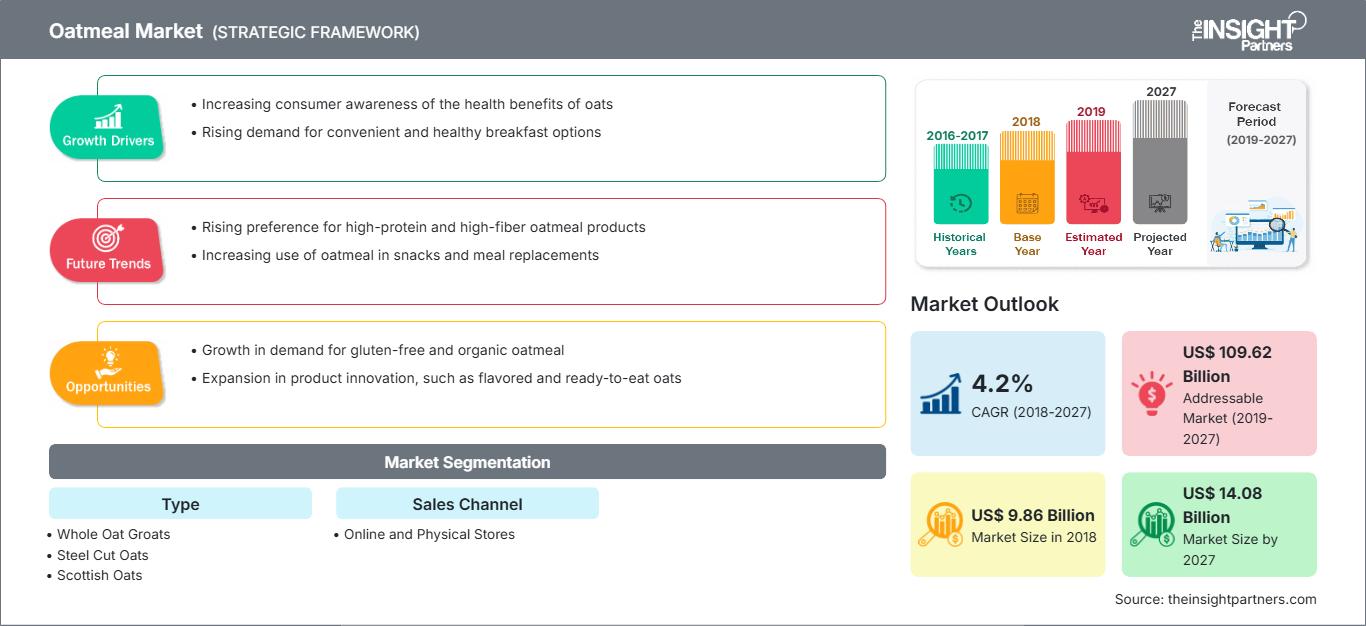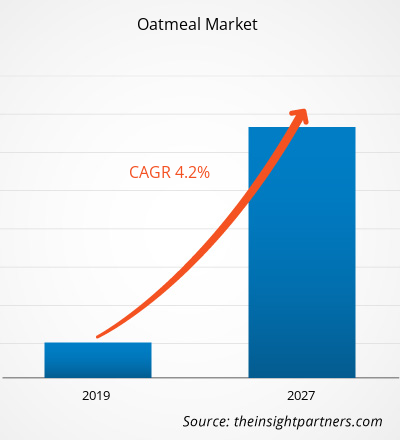[Forschungsbericht] Der Haferflockenmarkt hatte im Jahr 2018 ein Volumen von 9,86 Mrd. USD und wird im Prognosezeitraum 2019–2027 voraussichtlich mit einer durchschnittlichen jährlichen Wachstumsrate von 4,2 % wachsen und im Jahr 2027 14,08 Mrd. USD erreichen.
Haferflocken sind eine Art Frühstücksnahrung, die aus Hafer und Flüssigkeiten wie Wasser oder Milch zubereitet wird. Die Mahlzeit gilt als Kraftpaket an Nährstoffen und Geschmack. Der Haferflockenmarkt ist in den letzten Jahren rasant gewachsen. Steigendes verfügbares Einkommen und veränderte Lebensstile verleiten Verbraucher dazu, Haferflocken in ihre tägliche Ernährung zu integrieren. Hafer ist bekannt für sein reichhaltiges Nährwertprofil mit höherer biologischer Wertigkeit, einem größeren Anteil ungesättigter Fettsäuren und einem hohen Gehalt an löslichen und unlöslichen Ballaststoffen. Hafer enthält außerdem zahlreiche Mikronährstoffe und ist eine anerkannte Quelle für Eisen, Kalium, Kupfer, Magnesium, Thiamin, Folsäure, Zink und Phosphor. Zu den gängigsten Hafersorten für die Zubereitung von Haferflocken zählen derzeit Vollkornhafergrütze, Stahlschnitthafer, schottischer Hafer, normaler Haferflocken, Schnellhaferflocken, Instanthafer und Haferkleie. Führende Haferflockenhersteller wie McCann’s Irish Oatmeal, Hamlyns of Scotland, Nature’s Path Foods Inc., Nestlé SA und The Quaker Oats Company sowie andere namhafte Anbieter auf dem Haferflockenmarkt bieten ihrem großen Kundenstamm jedoch auch eine breite Palette aromatisierter Produkte auf Haferflockenbasis an.
Passen Sie diesen Bericht Ihren Anforderungen an
Sie erhalten kostenlos Anpassungen an jedem Bericht, einschließlich Teilen dieses Berichts oder einer Analyse auf Länderebene, eines Excel-Datenpakets sowie tolle Angebote und Rabatte für Start-ups und Universitäten.
Haferflockenmarkt: Strategische Einblicke

- Holen Sie sich die wichtigsten Markttrends aus diesem Bericht.Dieses KOSTENLOSE Beispiel umfasst Datenanalysen, die von Markttrends bis hin zu Schätzungen und Prognosen reichen.
Markteinblicke: Wandel des Lebensstils und Einführung gesunder Ernährungsgewohnheiten
Sie erhalten kostenlos Anpassungen an jedem Bericht, einschließlich Teilen dieses Berichts oder einer Analyse auf Länderebene, eines Excel-Datenpakets sowie tolle Angebote und Rabatte für Start-ups und Universitäten.
Haferflockenmarkt: Strategische Einblicke

- Holen Sie sich die wichtigsten Markttrends aus diesem Bericht.Dieses KOSTENLOSE Beispiel umfasst Datenanalysen, die von Markttrends bis hin zu Schätzungen und Prognosen reichen.
Mit dem Wandel des Lebensstils und dem Anstieg des verfügbaren Einkommens freuen sich die Verbraucher auf einen gesünderen Lebensstil, insbesondere in führenden Großstädten und Metropolen. Darüber hinaus hat die steigende Beliebtheit veganer und glutenfreier Lebensmittel in den entwickelten Volkswirtschaften Nordamerikas, Europas und des asiatisch-pazifischen Raums auch eine erhebliche Nachfrage nach zahlreichen Lebensmitteln und Getränken auf Haferbasis angezogen. Darüber hinaus wird erwartet, dass die wachsende Zahl gesundheitsbewusster Personen und ein deutlich gestiegenes Bewusstsein für die gesundheitlichen Vorteile von Haferflocken das Marktwachstum in den kommenden Jahren vorantreiben werden. Darüber hinaus hat die Verfügbarkeit von biologischen, glutenfreien, veganen und nährstoffreichen Haferflockenprodukten zu einer erheblichen Durchdringung unter jungen Menschen in den aufstrebenden Städten der Entwicklungsländer geführt.
Typbasierte Einblicke
Der Haferflockenmarkt ist je nach Typ in Vollkornhafergrütze, Steel Cut Oats, Scottish Oats, Normal- und Schnell gerollte Haferflocken, Instant-Haferflocken und mehr. Im Jahr 2018 galten normale und schnell gerollte Haferflocken als eines der lukrativsten Segmente auf dem Haferflockenmarkt. Haferflocken werden aus geschälten Haferkörnern hergestellt, die gewalzt, gemahlen oder grob geschnitten werden. Die ballaststoff- und proteinreiche Mahlzeit hilft dem Verbraucher, sein Körpergewicht zu halten, da Haferflocken aufgrund ihrer langsamen Verdauung das Hungergefühl reduzieren. Sie bietet außerdem mehrere gesundheitliche Vorteile, darunter eine Senkung des Blutzucker- und Cholesterinspiegels, einen niedrigeren Blutdruck, ein verringertes Risiko für Asthma im Kindesalter und kann auch in die Hautpflege integriert werden. Es gibt verschiedene Hafersorten auf dem Markt. Ihr Nährwert ist jedoch nahezu gleich; sie unterscheiden sich je nach Textur, Verwendung und Verarbeitung.
Einblicke nach Vertriebskanälen
Der Haferflockenmarkt ist nach Vertriebskanälen in Online- und stationäre Geschäfte unterteilt. Im Jahr 2018 gilt das allgemeine Wellness-Segment als eines der lukrativsten Segmente im Haferflockenmarkt. Das Segment der stationären Geschäfte wird voraussichtlich einen großen Marktanteil halten, während das Online-Segment das am schnellsten wachsende Segment im Haferflockenmarkt ist. Dies ist auf die Entwicklung von E-Commerce-Möglichkeiten zurückzuführen, und der zunehmende Trend zum Online-Vertrieb der Produkte dürfte im Prognosezeitraum zunehmen.
Einige wichtige Akteure auf dem globalen Haferflockenmarkt sind B&G Food, Inc., Bagrrys India Limited, Kellogg Company und Nestlé SA. Wichtige Marktteilnehmer konzentrieren sich auf Strategien wie Fusionen und Übernahmen sowie Produkteinführungen, um ihre geografische Präsenz und Kundenbasis weltweit zu vergrößern. So erwarb B&G Foods beispielsweise im Jahr 2018 McCann’s, eine Premium-Haferflockenmarke von TreeHouse Foods, Inc., für rund 32,0 Millionen US-Dollar in bar.
Berichts-Spotlights
- Fortschreitende Branchentrends auf dem Haferflockenmarkt helfen den Akteuren bei der Entwicklung effektiver langfristiger Strategien
- Geschäftswachstumsstrategien in entwickelten und sich entwickelnden Märkten
- Quantitative Analyse des Haferflockenmarktes von 2017 bis 2027
- Schätzung der Nachfrage nach Düngemittelzusätzen in verschiedenen Branchen
- PEST-Analyse zur Veranschaulichung der Wirksamkeit von in der Branche tätigen Käufern und Lieferanten zur Vorhersage des Marktwachstums
- Jüngste Entwicklungen zum Verständnis des Wettbewerbsmarktszenarios und der Nachfrage nach Düngemittelzusätzen
- Markttrends und -aussichten in Verbindung mit Faktoren, die das Wachstum des Haferflockenmarktes vorantreiben und hemmen
- Verständnis der Strategien, die das kommerzielle Interesse in Bezug auf Wachstum des Haferflockenmarktes, was den Entscheidungsprozess für die Beteiligten erleichtert
- Größe des Haferflockenmarktes an verschiedenen Marktknotenpunkten
- Detaillierte Übersicht und Segmentierung des Haferflockenmarktes sowie seine Dynamik in der Branche
HaferflockenRegionale Einblicke in den Haferflockenmarkt
Die Analysten von The Insight Partners haben die regionalen Trends und Faktoren, die den Haferflockenmarkt im Prognosezeitraum beeinflussen, ausführlich erläutert. In diesem Abschnitt werden auch die Marktsegmente und die geografische Lage in Nordamerika, Europa, dem asiatisch-pazifischen Raum, dem Nahen Osten und Afrika sowie Süd- und Mittelamerika erörtert.
Umfang des Haferflockenmarktberichts
| Berichtsattribut | Einzelheiten |
|---|---|
| Marktgröße in 2018 | US$ 9.86 Billion |
| Marktgröße nach 2027 | US$ 14.08 Billion |
| Globale CAGR (2018 - 2027) | 4.2% |
| Historische Daten | 2016-2017 |
| Prognosezeitraum | 2019-2027 |
| Abgedeckte Segmente |
By Typ
|
| Abgedeckte Regionen und Länder | Nordamerika
|
| Marktführer und wichtige Unternehmensprofile |
|
Dichte der Akteure auf dem Haferflockenmarkt: Verständnis ihrer Auswirkungen auf die Geschäftsdynamik
Der Haferflockenmarkt wächst rasant, angetrieben von der steigenden Endverbrauchernachfrage aufgrund von Faktoren wie sich entwickelnden Verbraucherpräferenzen, technologischem Fortschritt und einem stärkeren Bewusstsein für die Produktvorteile. Mit steigender Nachfrage erweitern Unternehmen ihr Angebot, entwickeln Innovationen, um den Verbraucherbedürfnissen gerecht zu werden, und nutzen neue Trends, was das Marktwachstum weiter ankurbelt.

- Holen Sie sich die Haferflockenmarkt Übersicht der wichtigsten Akteure
- Vollkornhafer
- Stahlschnitthafer
- Schottischer Hafer
- Normale und schnell gerollte Haferflocken
- Instant-Hafer
- Sonstige
Globaler Haferflockenmarkt – nach Vertriebskanal
- Online
- Ladengeschäfte
Firmenprofile
- B&G Food, Inc. (McCann’s Irish Oatmeal)
- Bagrrys India Limited
- Grain Millers, Inc.
- Hamlyns Of Scotland
- Kellogg Company
- Marico Limited
- Nature’s Path Foods, Inc.
- Nestlé SA
- The Quaker Oats Company
- Weetabix Limited
- Historische Analyse (2 Jahre), Basisjahr, Prognose (7 Jahre) mit CAGR
- PEST- und SWOT-Analyse
- Marktgröße Wert/Volumen – Global, Regional, Land
- Branchen- und Wettbewerbslandschaft
- Excel-Datensatz
Aktuelle Berichte
Erfahrungsberichte
Grund zum Kauf
- Fundierte Entscheidungsfindung
- Marktdynamik verstehen
- Wettbewerbsanalyse
- Kundeneinblicke
- Marktprognosen
- Risikominimierung
- Strategische Planung
- Investitionsbegründung
- Identifizierung neuer Märkte
- Verbesserung von Marketingstrategien
- Steigerung der Betriebseffizienz
- Anpassung an regulatorische Trends






















 Kostenlose Probe anfordern für - Haferflockenmarkt
Kostenlose Probe anfordern für - Haferflockenmarkt